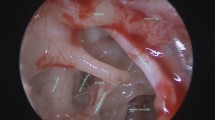Abstract
Purpose
To present a modified method of local infiltration (MMLI) for endoscopic stapes surgery to reduce surgical time, bleeding and complications.
Materials and methods
This study involved 70 patients who underwent stapes surgery for otosclerosis by endoscopic and microscopic approaches. The MMLI was applied as follows: local infiltration was performed with one hand while the other hand inserted the endoscope into the ear canal to observe vasoconstriction signs on the monitor; the single site of infiltration was located at the center of the anterior conchal cartilage. Operative time, intraoperative blood loss, preservation of anatomical structures, postoperative hearing and complications were evaluated.
Results
The MMLI allowed for quick bleeding control and a clear and dry operative field. Operative time, intraoperative blood loss and preservation of anatomical structures were significantly reduced in the endoscopic group (P < 0.00) versus the microscopic group. The scutum was removed less frequent in the endoscopic group 7.1% versus 53.6% of the microscopic group (P < 0.00). The chorda tympani was preserved in all cases but it was more manipulated in the microscopic group 39.3% versus 9.5% of the endoscopic group (P < 0.00). No complications were observed and the hearing outcomes were significantly better than the preoperative thresholds.
Conclusions
This is the first report on the use of a MMLI for endoscopic stapes surgery. Using this method, the surgeon performs the infiltration at one site and concurrently observes the vasoconstriction signs without the use of a microscope, frontal lamp or speculum. This method provides benefits in terms of operative time and complications.



Similar content being viewed by others
Abbreviations
- MMLI:
-
Modified method of local infiltration
References
Caner G, Olgun L, Gültekin G, Aydar L (2005) Local anesthesia for middle ear surgery. Otolaryngol Head Neck Surg 133:295–297
Lavy JA, Powell HRF (2013) Stapes surgery under local anaesthesia. Ann R Coll Surg Engl 95:37–39
Migirov L, Wolf M (2013) Endoscopic transcanal stapedotomy: how I do it. Eur Arch Otorhinolaryngol 270:1547–1549
Dursun E, Özgür A, Terzi S, Oğurlu M, Coşkun Z, Demirci M (2016) Endoscopic transcanal stapes surgery: our technique and outcomes. Kulak Burun Bogaz Ihtis Derg 26:201–206
Sarkar S, Banerjee S, Chakravarty S, Singh R, Sikder B, Bera SP (2013) Endoscopic stapes surgery: our experience in thirty two patients. Clin Otolaryngol 38:157–160
Kojima H, Komori M, Chikazawa S, Yaguchi Y, Yamamoto K, Chujo K et al (2014) Comparison between endoscopic and microscopic stapes surgery. Laryngoscope 124:266–271
El-Begermy MA, El-Begermy MM, Rabie AN, Ezzat AEM, Kader Sheesh AA (2016) Use of local anesthesia in ear surgery: technique, modifications, advantages and limitations over 30 years’ experience. Egypt J Otolaryngol 32:161–169
Bien AG, Wagner R, Wilkinson EP (2007) Local and regional anaesthesia techniques for otologic (ear) surgery. Open Access Atlas of Otolaryngology, Head & Neck Operative Surgery. https://vula.uct.ac.za/access/content/group/ba5fb1bd-be95-48e5-81be-586fbaeba29d/Otology%20outreach%20surgery%20techniques%20under%20local%20and%20regional%20anaesthesia.pdf. Accessed 2014
Tos M (1993) Manual of middle ear surgery, vol 1: approaches, myringoplasty, ossiculoplasty and tympanoplasty. Thieme Medical Publishers, Inc, New York, pp 5–13
Morizono T (1996) Endaural approaches. Operative techniques in Otolaryngology. Head Neck Surg 7:66–70
Nogueira Junior JF, Martins MJ, Aguiar CV, Pinheiro A (2011) Fully endoscopic stapes surgery (stapedotomy): techniques and preliminary results. Braz J Otorhinolaryngol 77:721–727
Shoroghi M, Sadrolsadat SH, Razzaghi M, Farahbakhsh F, Sheikhvatan M, Sheikhfathollahi M et al (2008) Effect of different epinephrine concentrations on local bleeding and hemodynamics during dermatologic surgery. Acta Dermatovenerol Croat 16:209–2014
Özdek A, Bayir Ö, Keseroglu K, Tatar EC, Öcal B, Korkmaz MH (2016) Fully endoscopic stapes surgery: preliminary results. Ann Otolaryngol Rhinol 3:1085–1088
Tarabichi M (2010) Endoscopic transcanal middle ear surgery. Indian J Otolaryngol Head Neck Surg 62:6–24
Iannella G, Magliulo G (2016) Endoscopic versus microscopic approach in stapes surgery: are operative times and learning curve important for making the choice? Otol Neurotol 37:1350–1357
Naik C, Nemade S (2016) Endoscopic stapedotomy: our view point. Eur Arch Otorhinolaryngol 273:37–41
Hunter JB, Zuniga MG, Leite J, Killeen D, Wick C, Ramirez J et al (2016) Surgical and audiologic outcomes in endoscopic stapes surgery across 4 institutions. Otolaryngol Head Neck Surg 154:1093–1098
Miuchi S, Sakagami M, Tsuzuki K, Noguchi K, Mishiro Y, Katsura H (2009) Taste disturbance after stapes surgery-clinical and experimental study. Acta Otolaryngol Suppl 562:71–78
Guder E, Böttcher A, Pau HW, Just T (2012) Taste function after stapes surgery. Auris Nasus Larynx 39:562–566
Acknowledgements
The authors thank Guillermo Aguirre for their valuable help with the figures and photographic material. In addition, the authors thank Jessica Bañuelos Cornejo for her drawings.
Funding
This research did not receive any specific grant from funding agencies in the public, commercial, or not-for-profit sectors.
Author information
Authors and Affiliations
Corresponding author
Ethics declarations
Conflict of interest
The author(s) declare no potential conflicts of interest with respect to the research, authorship and/or publication of this article.
Rights and permissions
About this article
Cite this article
Cornejo-Suarez, A., Chavez-Delgado, M.E., Perez-Ramirez, R. et al. A modified method of local infiltration for endoscopic stapes surgery: how I do it. Eur Arch Otorhinolaryngol 276, 357–365 (2019). https://doi.org/10.1007/s00405-018-5238-3
Received:
Accepted:
Published:
Issue Date:
DOI: https://doi.org/10.1007/s00405-018-5238-3




